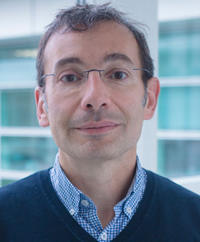
I was educated as an electrical engineer in France at the Ecole Normale Superieure de Cachan in the early 90’s and was fascinated by potential applications of mathematics to engineering problems and how mathematics could have a greater impact on key societal issues. At that time, mathematics was quite important in Signal Processing and Control Theory. In France, the standard curriculum in EE would provide practical understanding of distribution theory, rudimentary probability theory and basic statistical analysis, Fourier analysis and a taste of complex variables. At the same time, Signal Processing was completely transfigured by the discovery of Wavelet theory. Wavelets were starting to become key tools in image analysis, non-parametric statistics and numerical solution of PDE’s among many other applications and the impact of wavelet theory on compression, denoising and image and signal analysis turned out to be of paramount importance. Control theory started to incorporate new techniques from algebra (e.g. differential algebra, flatness, …), operator theory (Hankel operators), PDEs, etc. At the precise same time, Convex Optimisation and in particular Semi-Definite Programming was about to become one of the most impactful advances in numerical mathematics with amazing applications (H-infinity control, Combinatorial Optimisation, Robust Linear and Quadratic Programming, etc). For a beginning graduate student, being a witness of these revolutions left a lasting impression of privilege and at the same time a little bit of frustration. At that time, EE students did not receive the necessary background for digesting these marvelous results and I felt quite left behind due to the complexity of the mathematical technicalities involved. The books on wavelets, on optimisation and computational complexity, most books on PDE’s and worst, in computational differential algebra, were inaccessible to the average engineer with poor preparation in functional analysis, harmonic analysis, algebra, computer science, etc. Despite these obstructions, I kept trying to slowly acquire better understanding of these new fields and how they would progress and connect with other topics during the two decades that followed and finally got a sounder understanding through numerous discussions and exchanges with experts. Motivation from important engineering applications always was the most important driver for my continued enthusiasm for new mathematical concepts. After one decade and a half as a happy teacher and researcher in academia, I had the great pleasure to join the National Physical Laboratory in the Data Science division. The NPL is an amazing place where we exchange scientific ideas and apply them to industrial problems. At NPL, mathematics is fundamental to Quantum Mechanics, Mass Spectrum Imaging, Tomography, Planning, Sensor Network Analysis, Biology, Medicine, Finance, etc. A lot of work is done in our team in order to address a wide range of sensitive topics in a fast changing world and provide better understanding about what is really reliable and what isn’t. We extensively use machine learning, compressed sensing, convex optimisation, PDE’s, high dimensional approximation, etc. The lessons I have learnt from both academia and industry are numerous and converge to the essential idea that mathematics classifies and clarifies. Understanding that the same mathematical idea can apply to different problems is a surprising experience that helps you realise that you can contribute to many impactful projects at the same time and learn from each of them about the limitations of your knowledge. I also had the chance to realise over the years that mathematics experiences new exciting revolutions at quite an amazing pace and that these revolutions involve quite accessible notions that get quickly shared and popularised by a generous commmunity so that young people can easily join the movement and contribute their own ideas. Mathematics progresses transversally and the door is always open to different practice and backgrounds. This is even more so as fields connect and enrich each other along the years. I discovered that mathematics helped me to get a much better insight on the topics I thought I was mastering and the resulting progress was essential in addressing long standing questions I had about solving a particular practical problem. Computer scientists and electrical engineers are now closer to the boundaries with mathematical sciences than ever and even often cross them. I sometimes think that the new century is a perfect time to learn and apply the multifaceted magic of mathematics whatever your background. Join the community!
